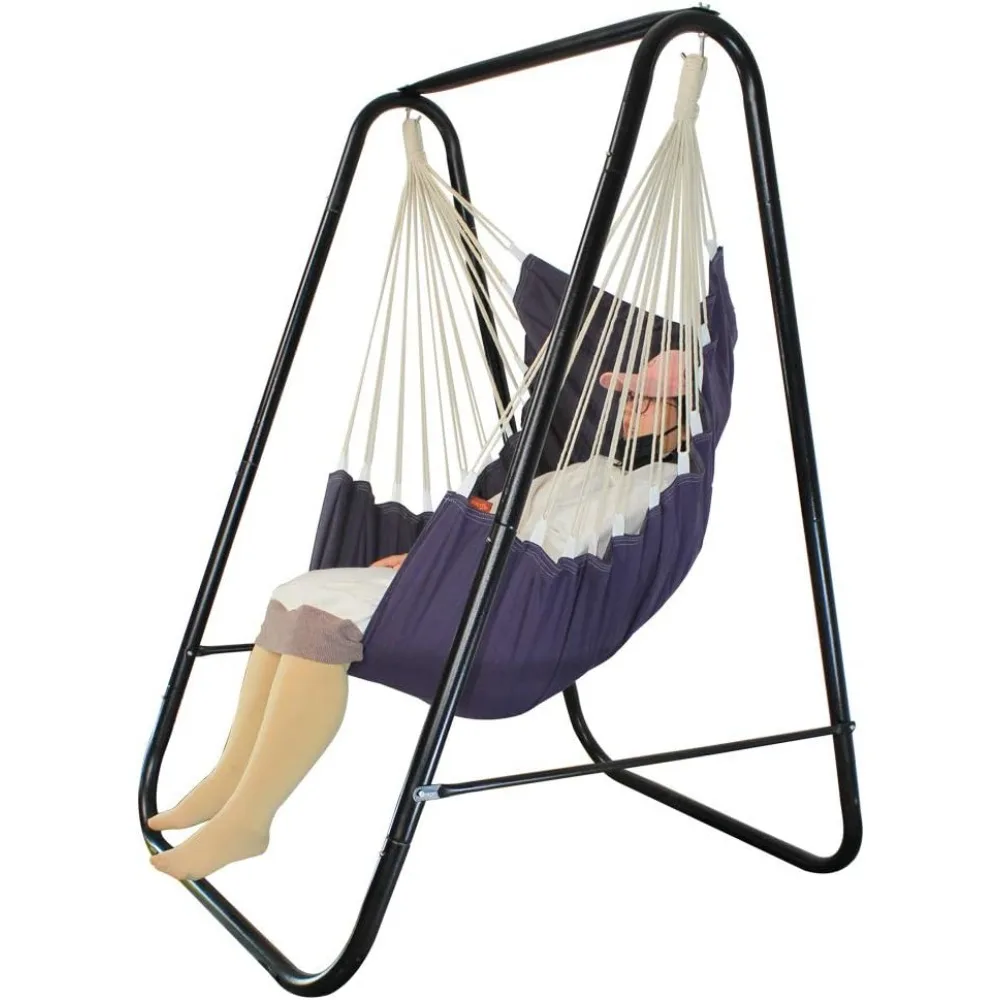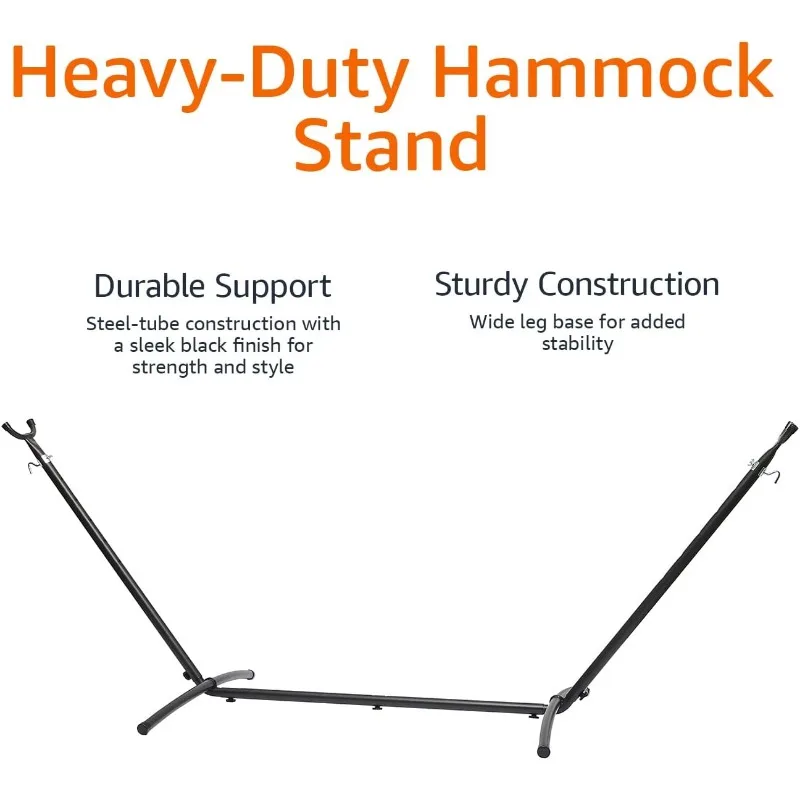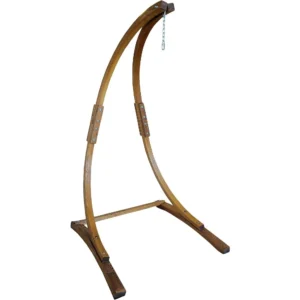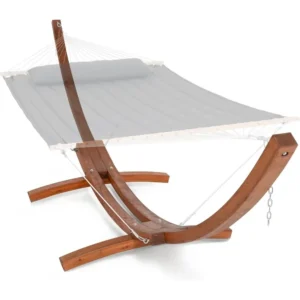Understanding the Basics: Porch Swing Hammock Installation
Porch swing hammocks combine the gentle swaying motion of a hammock with the comfortable seating of a porch swing, creating an ideal outdoor relaxation space. While these versatile fixtures add both function and charm to any porch, proper installation is critical for both safety and enjoyment.
Installing a porch swing hammock is a moderate DIY project that most homeowners can accomplish with the right tools and preparation. The process involves three main phases: careful planning, proper installation, and thorough testing. Each phase plays a vital role in ensuring your swing provides years of safe relaxation.
Safety should be your primary concern throughout this project. Most importantly, you must consider weight capacity at every step – from hardware selection to structural assessment. Typical porch swing hammocks support between 250-600 pounds (113-272 kg), but this capacity is only valid when properly installed.
Key considerations before starting:
– Installation requires basic DIY skills and knowledge of hand tools
– The project typically takes 2-4 hours to complete
– Your porch’s structural integrity is non-negotiable
– Every component must be rated for your intended weight capacity
Understanding the ultimate guide to porch swing hammocks helps establish a solid foundation before beginning your installation project.
Essential Safety Precautions Before Starting Your Installation
Safety must be your top priority when installing a porch swing hammock. Here are the critical precautions to take before beginning:
Weight Capacity Considerations:
– Always check manufacturer specifications for your specific hammock’s weight limit
– Remember that hardware must be rated at least 50% higher than the hammock’s capacity
– Your porch structure must support both the static weight and dynamic forces of swinging
Structural Assessment:
– Examine your porch ceiling for signs of damage or weakness (water stains, sagging, cracks)
– Identify load-bearing beams or joists – never mount to decorative elements or fascia boards
– Consider the age and condition of your porch structure
Warning Signs That Require Professional Help:
– Visible structural damage or deterioration
– Uncertainty about joist location or strength
– Older homes with modified porches
– Ceilings with unusual construction or materials
Understanding exactly how much weight can a hammock hold is essential for selecting appropriate installation hardware and methods. The combined weight of users plus the hammock itself determines your minimum requirements.
Required Safety Equipment:
– Safety glasses to protect eyes during drilling
– Work gloves for hardware handling
– Sturdy step ladder rated for your weight
– Hard hat if working on high porches
Selecting the Perfect Location for Your Porch Swing Hammock
Finding the ideal spot for your porch swing hammock balances practical clearance requirements with aesthetic and comfort preferences. Take time to carefully evaluate potential locations before making your decision.
Minimum Clearance Requirements:
– Front and back: At least 3-4 feet (0.9-1.2 m) to allow full swinging motion
– Sides: Minimum 2 feet (0.6 m) from walls or railings
– Overhead: 1-2 feet (0.3-0.6 m) above the hanging point for chain/rope clearance
– Bottom: 17-19 inches (43-48 cm) from floor to seat for comfortable adult seating
Consider how the swing will affect movement patterns on your porch. The location should allow easy passage around the swing even when in use. For maximum enjoyment, position your swing where it can capture pleasant views, optimal shade during peak use hours, and protection from prevailing winds.
The location you choose directly impacts the installation approach. Corner installations might require special mounting considerations, while central locations need to align precisely with ceiling joists. Exploring different perfect porch swing hammock locations can help you envision the best setup for your specific space.
Identifying Proper Structural Support in Your Porch
Finding suitable structural support is perhaps the most critical step in your installation process. Your porch swing hammock must be attached to solid, load-bearing elements that can safely handle both static weight and dynamic swinging forces.
Locating Ceiling Joists:
1. Use a stud finder to scan the ceiling systematically
2. Mark potential joist locations with painter’s tape
3. Verify findings by tapping the ceiling (solid areas produce a dull thud)
4. Confirm with a small drill bit by making a test hole
For porches with exposed beams, visual inspection is sufficient. Look for main support beams rather than decorative trim pieces. In finished ceilings, joists typically run perpendicular to the house wall and are spaced 16-24 inches (41-61 cm) apart.
Evaluating Joist Strength:
– Minimum acceptable joist size: 2×6 inches (5×15 cm) solid wood
– Preferred joist size: 2×8 inches (5×20 cm) or larger
– Metal joists require special evaluation and hardware
If your existing structure seems inadequate, you may need to install a support board across multiple joists to distribute the weight properly. This involves mounting a 2×8 or 2×10 board (5×20 or 5×25 cm) perpendicular to the ceiling joists, securing it to at least three joists.
Determining if your ceiling can support a hammock requires careful assessment of both materials and construction methods. When in doubt, consult a professional, especially in older homes or with unusual ceiling construction.
Choosing the Right Hanging Hardware for Your Porch Swing Hammock
The hardware you select must balance strength, durability, and compatibility with both your swing and porch structure. Quality hardware is not an area to compromise on cost.
| Hardware Type | Best For | Weight Capacity | Weather Resistance |
|---|---|---|---|
| Stainless Steel Eye Bolts | Direct joist mounting | 400-600 lbs (181-272 kg) | Excellent |
| Galvanized Lag Screws with Hooks | Wood beam mounting | 300-500 lbs (136-227 kg) | Very Good |
| Heavy-Duty Ceiling Hooks | Reinforced mounting points | 300-800 lbs (136-363 kg) | Good to Excellent |
| Specialized Swing Hangers | Decorative installations | 400-700 lbs (181-318 kg) | Varies by material |
For most porch swing hammock installations, stainless steel hardware offers the best combination of strength and weather resistance. While slightly more expensive, it prevents rust staining on your porch ceiling and provides superior longevity.
The diameter of your hardware matters significantly:
– Minimum diameter for eye bolts: 3/8 inch (10 mm)
– Recommended for heavier swings: 1/2 inch (13 mm)
– Screw-in portion length: At least 3-4 inches (7.6-10 cm)
For chain or rope connections, use locking carabiners or quick links rated for at least 1000 pounds (454 kg) to ensure safety. Understanding different types of ultimate guide heavy-duty hammock stands provides valuable insights on support systems, even for ceiling-mounted installations.
Essential Tools and Materials Checklist
Having all necessary tools and materials ready before starting makes the installation process smoother and safer. Here’s everything you’ll need:
Required Tools:
– Electric drill with various drill bits (including 1/8”, 1/4”, and 3/8”)
– Adjustable wrench or socket set
– Tape measure (at least 10 ft/3 m long)
– Stud finder
– Level (2 ft/60 cm recommended)
– Step ladder rated for your weight
– Pencil for marking
– Safety glasses and work gloves
Required Materials:
– Mounting hardware (eye bolts, lag screws, or specialized hangers)
– Chains or ropes (rated for at least twice your weight capacity)
– S-hooks or carabiners for connections
– Washers (both standard and lock washers)
– Backing plates for added strength (optional but recommended)
– Weather sealant for outdoor installations
Optional Tools That Help:
– Hammer drill (for masonry porches)
– Ratchet set for easier tightening
– Helper to assist with holding the swing during mounting
– Electric stud finder for more precise joist location

Step 1: Measuring and Marking Your Installation Points
Precise measurements ensure your porch swing hammock hangs level and secure. Take your time with this critical first step.
- Measure your swing’s width and add 4-6 inches (10-15 cm) on each side for chain clearance.
- Locate the ceiling joists in your desired location using a stud finder.
- Mark the center of each joist where your hanging points will be installed.
Measure the distance between these two points – they should be:
– For traditional porch swings: 4-6 inches (10-15 cm) wider than your swing’s width
– For swing hammock chairs: directly above the center point or according to manufacturer specificationsVerify your marks are aligned with the joists by drilling a small pilot hole (1/16 inch/1.5 mm) at each location.
- Use a level to ensure your mounting points are at the same height – uneven mounting will cause your swing to tilt.
For specialized installations like corner placement, you’ll need to adapt these measurements while maintaining proper ultimate relaxation porch swing hammocks positioning for optimal comfort and function.
Step 2: Proper Drilling Techniques for Secure Mounting
Creating proper holes for your mounting hardware is critical for both safety and longevity of your installation.
Select the correct drill bit size:
– For eye bolts or lag screws: Choose a bit 1/8 inch (3 mm) smaller than the bolt diameter
– For expansion bolts: Follow manufacturer specifications exactlyPosition your drill perpendicular to the ceiling surface. Any angle other than 90 degrees reduces the hardware’s holding power.
Drill slowly and steadily, applying even pressure. Too much force can split wood joists.
For wood joists: Drill to a depth equal to the threaded portion of your hardware minus 1/4 inch (6 mm). This ensures the hardware bites securely into solid wood.
Clean out any sawdust from the holes to ensure hardware seats properly.
Safety tips while drilling:
– Always wear eye protection
– Position yourself safely on the ladder
– Never drill directly overhead – offset your position slightly
– Support the drill properly, especially when finishing the hole
Various porch swing chair sets require different mounting approaches, so adjust your drilling technique based on your specific hammock style and weight requirements.
Step 3: Installing Your Ceiling Hardware Correctly
With proper holes drilled, it’s time to install your ceiling hardware securely.
For eye bolts and lag screws:
1. Apply a small amount of weatherproof sealant around the hole to prevent moisture penetration.
2. Place a washer on the bolt/screw.
3. Thread the hardware into the drilled hole by hand until tight.
4. Use a wrench or socket to tighten the hardware until firmly seated against the ceiling.
5. For maximum security, tighten until the eye bolt or hook is oriented in the direction your chains will hang.
For specialized hangers:
1. Follow the manufacturer’s instructions precisely.
2. Most require you to insert the bolt portion through the pre-drilled hole.
3. Secure from above with washers and nuts if accessible from attic space.
Important considerations:
– Never force hardware – if significant resistance occurs, remove and check the hole.
– Eye bolts should penetrate at least 2-3 inches (5-7.6 cm) into solid wood.
– For finished ceilings, use backing plates to distribute weight across a larger surface area.
– For outdoor installations, apply clear silicone sealant around the hardware to prevent water intrusion.
Many swinging hammock chair sets include specific hardware – always prioritize manufacturer recommendations over general guidelines when they differ.
Step 4: Preparing and Attaching Chains or Ropes
The connections between your ceiling hardware and the swing itself must be carefully measured and secured.
For chain installations:
1. Measure the desired hanging height. Standard porch swings typically hang with the seat 17-19 inches (43-48 cm) from the floor.
2. Cut chains to equal length, allowing for connection hardware at both ends.
3. Secure chains to ceiling hardware using locking carabiners or S-hooks with the opening facing outward away from the swing.
4. Close S-hooks completely with pliers to prevent accidental disconnection.
For rope installations:
1. Cut rope lengths with an additional 12 inches (30 cm) for knot tying.
2. Use marine-grade or weather-resistant synthetic rope for outdoor installations.
3. Attach to ceiling hardware using a secure knot such as a bowline or figure-eight follow-through.
4. Seal rope ends with heat or whipping to prevent fraying.
Important safety checks:
– Ensure all connection points can support at least twice your weight capacity
– Verify chains or ropes are exactly equal length for level hanging
– Check that all connection hardware is fully closed and secure
– Test each connection point individually before proceeding

Step 5: Hanging and Adjusting Your Porch Swing Hammock
With all hardware securely in place, you’re ready to hang your porch swing hammock.
- Recruit a helper to assist with lifting and positioning the swing.
- Attach one side of the swing to its corresponding ceiling chain/rope.
- Carefully attach the second side while keeping the swing level.
Adjust chain links or rope length as needed to achieve:
– Proper height: seat should be 17-19 inches (43-48 cm) from floor
– Level positioning: check with a level across the seat
– Appropriate angle: most swings should hang with a slight backward tilt (2-3 degrees) for comfortFor fine-tuning height and levelness:
– With chains: Add or remove links at connection points
– With ropes: Adjust knots or use rope tensioners
Before applying full weight, check that the swing hangs freely and hardware shows no signs of bending or pulling away from the ceiling. The proper installation of heavy-duty hammock sets requires careful attention to these final adjustments for optimal safety and comfort.
Thorough Testing for Safety and Stability
Before enjoying your newly installed porch swing hammock, perform these critical safety tests:
Visual Inspection:
– Examine all connection points for proper alignment
– Check that all S-hooks or carabiners are completely closed
– Verify that hardware remains firmly seated against the ceiling
– Look for any signs of wood splitting or structural stress
Graduated Weight Testing:
1. Apply gentle pressure on the swing (about 50 pounds/23 kg)
2. Listen for unusual creaking or observe any movement in ceiling hardware
3. Gradually increase weight to 100 pounds (45 kg)
4. Progress to actual weight capacity with gentle swinging motion
5. Test with dynamic movement (gentle swinging) at full capacity
Warning Signs to Address Immediately:
– Any creaking or cracking sounds from the ceiling
– Visible movement of hardware in ceiling
– Uneven settling of the swing
– Excessive swaying or instability
Regular safety inspections should become part of your durable hammock stand relaxation routine to ensure ongoing stability and safety.
Weatherproofing Your Installation for Longevity
Proper weatherproofing significantly extends the life of your porch swing hammock installation, especially in exposed areas.
For hardware protection:
– Apply clear silicone sealant around ceiling mounting points
– Use marine-grade lubricant on chains and moving parts
– Consider protective caps for exposed bolt ends
For wood components:
– Apply weather-resistant sealant to any exposed wood
– Consider transparent waterproofing spray for fabric components
– Use UV-protective treatments for all materials
Climate-specific considerations:
– Coastal areas: Use only stainless steel hardware and check for corrosion regularly
– Snowy regions: Remove excess snow weight promptly in winter
– Hot, sunny locations: Apply UV protectant to prevent premature material degradation
Selecting the right best material outdoor hammocks for your climate conditions significantly impacts longevity and maintenance requirements.
Essential Maintenance Schedule for Your Porch Swing Hammock
Regular maintenance ensures both safety and longevity for your porch swing hammock installation.
Monthly Checks:
– Visual inspection of all hardware and connection points
– Gentle cleaning of accumulated dust or debris
– Check for any loose connections or hardware
Seasonal Maintenance:
– Spring: Thorough cleaning and hardware tightening after winter
– Summer: Mid-season inspection during peak use
– Fall: Weatherproofing treatment before winter
– Winter: Snow removal if applicable and covering if not in use
Hardware Tightening Protocol:
1. Remove any load from the swing
2. Check each connection point with appropriate tools
3. Tighten any loose hardware to proper specifications
4. Reapply weatherproofing as needed
Signs Requiring Immediate Attention:
– Visible rust on hardware
– Fraying in ropes or chains
– Cracks in wooden components
– Any unusual movement or sounds during use

Troubleshooting Common Installation Issues
Even careful installations sometimes develop issues. Here’s how to address common problems:
Uneven Hanging or Tilting:
– Problem: Swing hangs at an angle or tilts to one side
– Solution: Adjust chain/rope length on one side by adding/removing links or adjusting knots
Squeaking or Creaking:
– Problem: Noisy operation during swinging
– Solution: Apply silicone lubricant to chain links or hardware connection points
Hardware Loosening:
– Problem: Eye bolts or hooks gradually backing out
– Solution: Remove hardware, apply thread-locking compound, and reinstall
Chain Stretching:
– Problem: Chains lengthen with use, causing the swing to sit lower
– Solution: Remove links to restore proper height or replace with higher-grade chain
Rope Stretching:
– Problem: Ropes elongate over time
– Solution: Retie knots or replace with pre-stretched marine-grade rope
Excessive Swaying:
– Problem: Swing moves too freely or feels unstable
– Solution: Add stabilizing cords at 45° angles to limit motion
Finding solutions for achieving perfect porch swing hammock comfort often involves making these minor adjustments after initial installation.
Dark Wood Hammock Sets, Porch Swing Chair Sets
$653.82 Select options This product has multiple variants. The options may be chosen on the product pageA-Frame Stand Hammock Sets, Swinging Hammock Chair Sets
$154.62 Select options This product has multiple variants. The options may be chosen on the product pageLight Wood Hammock Sets, Swinging Hammock Chair Sets
$1,359.35 Select options This product has multiple variants. The options may be chosen on the product pageClassic Wooden Stand Hammock Sets, Heavy Duty Hammock Sets
$1,061.68 Select options This product has multiple variants. The options may be chosen on the product pageHammock Sets with Canopy, Heavy Duty Hammock Sets
$286.31 Select options This product has multiple variants. The options may be chosen on the product pageHeavy Duty Hammock Sets, Wooden Arc Stand Hammock Sets
$878.66 Select options This product has multiple variants. The options may be chosen on the product page
Enhancing Your Porch Swing Hammock Experience
Once your porch swing hammock is securely installed, consider these enhancements for maximum enjoyment:
- Comfort Accessories: Add weather-resistant cushions and pillows that complement your outdoor décor while providing additional support
- Weather Protection: Install a small canopy or awning above your swing to extend usability during light rain or intense sun
- Ambient Lighting: Add string lights or small solar lanterns nearby for evening relaxation
- Side Tables: Place small weather-resistant tables within arm’s reach for beverages or books
- Plant Integration: Position potted plants nearby to create a more natural, relaxing environment
- Seasonal Decorations: Switch accessories seasonally to maintain visual interest and functionality year-round
These enhancements build upon your solid installation to transform porch swing comfort oasis with minimal additional effort. Focus on additions that don’t compromise structural integrity or add excessive weight to your installation.
When to Consult a Professional Installer
While most porch swing hammock installations are suitable DIY projects, certain situations warrant professional assistance:
Consider Professional Help When:
– Your porch ceiling has unusual construction or materials
– You’re unable to locate or confirm adequate structural supports
– The installation requires working at significant heights
– You notice structural issues during assessment
– Your swing will be exposed to extreme weather conditions
– The weight capacity exceeds typical residential standards
When selecting a professional:
– Choose contractors with specific experience installing porch fixtures
– Request references for similar installations
– Verify they carry appropriate insurance
– Get a detailed quote specifying hardware quality and methods
The cost for professional installation typically ranges from $100-300 depending on complexity and location, but this investment ensures safety and proper function. For complex setups, consulting the ultimate guide porch hammocks can help you communicate your exact needs to professionals.
By following this comprehensive guide from Outside Luxe, you can confidently install your porch swing hammock for years of relaxing enjoyment. Remember that taking your time with proper planning and installation techniques is the best way to ensure both safety and satisfaction with your new outdoor relaxation space.







